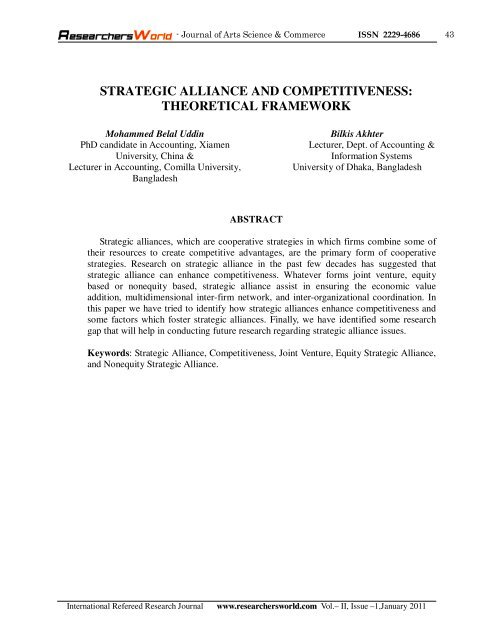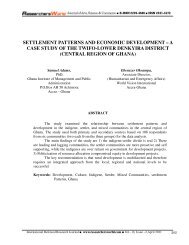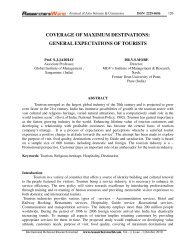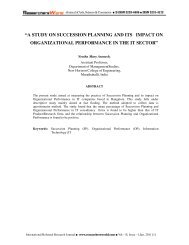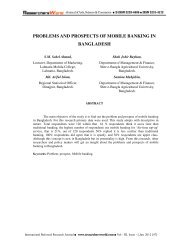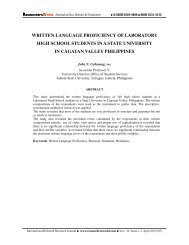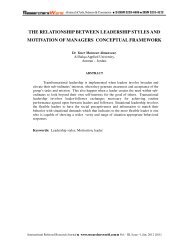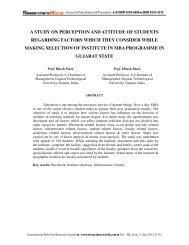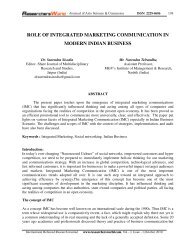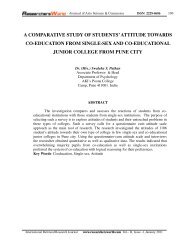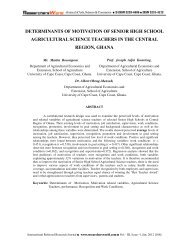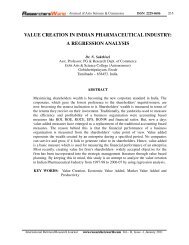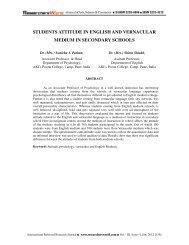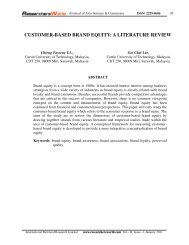strategic alliance and competitiveness: theoretical framework
strategic alliance and competitiveness: theoretical framework
strategic alliance and competitiveness: theoretical framework
You also want an ePaper? Increase the reach of your titles
YUMPU automatically turns print PDFs into web optimized ePapers that Google loves.
- Journal of Arts Science & Commerce ISSN 2229-4686<br />
43<br />
STRATEGIC ALLIANCE AND COMPETITIVENESS:<br />
THEORETICAL FRAMEWORK<br />
Mohammed Belal Uddin<br />
PhD c<strong>and</strong>idate in Accounting, Xiamen<br />
University, China &<br />
Lecturer in Accounting, Comilla University,<br />
Bangladesh<br />
Bilkis Akhter<br />
Lecturer, Dept. of Accounting &<br />
Information Systems<br />
University of Dhaka, Bangladesh<br />
ABSTRACT<br />
Strategic <strong>alliance</strong>s, which are cooperative strategies in which firms combine some of<br />
their resources to create competitive advantages, are the primary form of cooperative<br />
strategies. Research on <strong>strategic</strong> <strong>alliance</strong> in the past few decades has suggested that<br />
<strong>strategic</strong> <strong>alliance</strong> can enhance <strong>competitiveness</strong>. Whatever forms joint venture, equity<br />
based or nonequity based, <strong>strategic</strong> <strong>alliance</strong> assist in ensuring the economic value<br />
addition, multidimensional inter-firm network, <strong>and</strong> inter-organizational coordination. In<br />
this paper we have tried to identify how <strong>strategic</strong> <strong>alliance</strong>s enhance <strong>competitiveness</strong> <strong>and</strong><br />
some factors which foster <strong>strategic</strong> <strong>alliance</strong>s. Finally, we have identified some research<br />
gap that will help in conducting future research regarding <strong>strategic</strong> <strong>alliance</strong> issues.<br />
Keywords: Strategic Alliance, Competitiveness, Joint Venture, Equity Strategic Alliance,<br />
<strong>and</strong> Nonequity Strategic Alliance.<br />
International Refereed Research Journal www.researchersworld.com Vol.– II, Issue –1,January 2011
- Journal of Arts Science & Commerce ISSN 2229-4686<br />
44<br />
INTRODUCTION<br />
Strategic <strong>alliance</strong>s are increasingly becoming popular day by day. To achieve competitive<br />
advantages firms combine their assets <strong>and</strong> capabilities in a cooperative policy that is termed as<br />
<strong>strategic</strong> <strong>alliance</strong>. Strategic <strong>alliance</strong> is considered as an essential source of resource-sharing, learning,<br />
<strong>and</strong> thereby competitive advantage in the competitive business world. Management of <strong>alliance</strong> <strong>and</strong><br />
value creation to attain competitive advantage is very important in <strong>strategic</strong> <strong>alliance</strong> (Irel<strong>and</strong> et al,<br />
2002).<br />
Formation of relational capital dem<strong>and</strong>s an integrative approach to manage the contemporary<br />
conflict, <strong>and</strong> firms get the opportunity of both at the same time. Thus, as linkages between them<br />
<strong>strategic</strong> <strong>alliance</strong> involve firms with some degree of exchange <strong>and</strong> sharing of resources <strong>and</strong><br />
capabilities to co-develop or distribute goods or services (Kale et al, 2000). The achievement of<br />
competitive advantages is not possible by one firm itself because it does not possess required all<br />
resources <strong>and</strong> knowledge to be entrepreneurial <strong>and</strong> innovative in dynamic competitive markets.<br />
Interorganizational relationships create the opportunity to share the resources <strong>and</strong> capabilities of<br />
firms while working with partners to develop additional resources <strong>and</strong> capabilities as the function for<br />
new competitive advantages (Kuratko et al, 2001). “Unprecedented numbers of <strong>strategic</strong> <strong>alliance</strong>s<br />
between firms are being formed each year. (These) <strong>strategic</strong> <strong>alliance</strong>s are a logical <strong>and</strong> timely<br />
response to intense <strong>and</strong> rapid changes in economic activity, technology <strong>and</strong> globalization, all of<br />
which have cast many co operations into two competitive races: one for the world <strong>and</strong> another for the<br />
future” (Doz <strong>and</strong> Hamel, 1998). Many firms, especially large global competitors establish multiple<br />
<strong>strategic</strong> <strong>alliance</strong>s. General Motors’ <strong>alliance</strong>s, for example, “….. include a collaboration with Honda<br />
<strong>and</strong> internal combustion energies, with Toyota on advanced propulsion, with Renault on medium- <strong>and</strong><br />
heavy-duty vans for Europe <strong>and</strong>, in U.S., with AM general on the br<strong>and</strong> <strong>and</strong> distribution rights for the<br />
incomparable Hummer” (Dallas Morning News, 2002). Lockheed Martin has forms more than 250<br />
<strong>alliance</strong>s with firms concentrating on the defense modernization by providing special attention on<br />
developing advanced technologies (Martin, 2002). In general, <strong>strategic</strong> <strong>alliance</strong> success requires<br />
cooperative behavior from all partners. Alliance success depends on several factors such as, actively<br />
involvement in problem solution, being trustworthy; to create value combining partners resources <strong>and</strong><br />
capabilities, <strong>and</strong> persuasion among the partners for cooperation <strong>and</strong> coordination of activities in the<br />
cooperative organizational behavior. Conflict management practice <strong>and</strong> desire of achievement of<br />
competitive advantages in market also foster the <strong>alliance</strong> success (Tiessen <strong>and</strong> Linton, 2000). To<br />
identify an appropriate <strong>alliance</strong> structure requires more attention in the decision making process of<br />
<strong>alliance</strong> formation. Performance risk <strong>and</strong> relational risk are involved in choosing the partners to<br />
develop <strong>alliance</strong>s. Overall objective is to minimize total risk <strong>and</strong> ensuring competitive advantages. A<br />
competitive advantages developed through a cooperative strategy often is called a collaborative or<br />
rational advantage (Das <strong>and</strong> Teng, 2001). Competitive advantages significantly influence the firm’s<br />
market place success. By using technological capabilities firms can ensure customer value <strong>and</strong><br />
competitive advantage. (Afuah, 2002).Functional <strong>and</strong> educational experience provide an important<br />
dimension in competitive advantage. Rapid technological changes <strong>and</strong> the global economy are<br />
example of factors challenging firms to constantly upgrade current competitive advantages while they<br />
develop new ones to maintain <strong>strategic</strong> <strong>competitiveness</strong> (Geletkanycz, 2001).<br />
The objectives of this paper are, firstly, to review the <strong>strategic</strong> <strong>alliance</strong> literatures relating to<br />
<strong>competitiveness</strong> in the different forms of linkage networks. Secondly, identify the factors fostering<br />
the formation of <strong>alliance</strong>s <strong>and</strong> empirical evidences. Finally, provide hypotheses <strong>and</strong> scope for future<br />
research regarding this issue. This paper, in the next section, discusses the <strong>strategic</strong> <strong>alliance</strong> <strong>and</strong><br />
competiveness in different form of <strong>alliance</strong>s. A brief review of factors <strong>and</strong> empirical evidence<br />
regarding <strong>strategic</strong> <strong>alliance</strong> is provided in the third <strong>and</strong> fourth section respectively. The fifth section<br />
International Refereed Research Journal www.researchersworld.com Vol.– II, Issue –1,January 2011
- Journal of Arts Science & Commerce ISSN 2229-4686<br />
45<br />
briefly discusses the hypotheses <strong>and</strong> research questions. The paper ends with concluding remarks.<br />
Strategic Alliances <strong>and</strong> Competitiveness<br />
Evidence suggests that complementary business level <strong>strategic</strong> <strong>alliance</strong>, especially vertical ones,<br />
have the greatest probability of creating a sustainable competitive advantage. More <strong>and</strong> more<br />
companies are entering into <strong>alliance</strong>s to gain competitive advantages (Gari, 1999). Strategic <strong>alliance</strong><br />
designed to respond to competition <strong>and</strong> to reduce uncertainty can also create competitive advantages.<br />
However, these advantages tend to be more temporary those developed through complementary (both<br />
vertical <strong>and</strong> horizontal) <strong>strategic</strong> <strong>alliance</strong>s. The primary reason is that complementary <strong>alliance</strong>s have a<br />
stronger focus on the creation of value compared to competition reducing <strong>and</strong> uncertainty reducing<br />
<strong>alliance</strong>s, which tend to be formed to be respond to competitors’ actions rather than to attack<br />
competitors. The participants of corporate-level of strategies also can use the strategies to develop<br />
collaborate the knowledge for future success. Knowledge management is crucial for the firms to gain<br />
maximum value from this knowledge; firms should organize it <strong>and</strong> verify that it is always properly<br />
distributed to those involved with the formation <strong>and</strong> use of <strong>alliance</strong>s. To successfully commercialize<br />
inventions, firms may therefore choose to cooperate with other organizations <strong>and</strong> integrate their<br />
knowledge <strong>and</strong> resources (Simonin, 1997).<br />
Firms also use cross-border <strong>alliance</strong>s to help transform themselves or to better use their<br />
competitive advantages to take advantages of opportunities surfacing in the rapidly changing global<br />
economy. For example, GEC, a U.K. based company seeks to move from “a broadly focused group<br />
deriving much of its revenues from the defense budget to full range telecommunications <strong>and</strong><br />
information system manufacturer.” Networks have more than two components in relationships <strong>and</strong><br />
they characterize the association of components in close relationships also in existing market-based<br />
relationship. Participants’ role playing, performance evaluation, profit-sharing <strong>and</strong> risk management<br />
become more complex because of high concentration of trust in network (Tomkins, 2001). A network<br />
cooperative strategy is particularly effective when it is formed by firms clustered together, as with<br />
Silicon Valley in California <strong>and</strong> Singapore’s Silicon Isl<strong>and</strong> (Cohen <strong>and</strong> Fields, 1999). The <strong>strategic</strong><br />
<strong>alliance</strong>s can be mostly summarized into three dimensions: joint venture, equity <strong>strategic</strong> <strong>alliance</strong>,<br />
<strong>and</strong> nonequity <strong>strategic</strong> <strong>alliance</strong>. This section reviews the literature on how the three dimensions of<br />
<strong>strategic</strong> <strong>alliance</strong> may contribute to <strong>competitiveness</strong>.<br />
Joint Venture<br />
When two or more firms form a legally independent firm to share their collaborative capabilities<br />
<strong>and</strong> resources to achieve competitive advantages in the market is termed as joint venture in the form<br />
of <strong>strategic</strong> <strong>alliance</strong>. Joint ventures are effecting in establishing long-term relationship <strong>and</strong> in<br />
transferring tacit knowledge. Because it cannot be codified, tacit knowledge is learned through<br />
experiences (Berman et al, 2002) such as those taking place when people from partner firms work<br />
together in joint venture. Expertise <strong>and</strong> experience in particular field foster the sustainable<br />
competitive advantage. Tacit knowledge is an important source of competitive advantage for many<br />
firms (Tiessen <strong>and</strong> Linton, 2000).<br />
In a joint venture endeavor generally participating firms share resources <strong>and</strong> participate in the<br />
operations management equally. “Sprint <strong>and</strong> Virgin group’s joint venture, called Virgin Mobile USA,<br />
targets 15-to-30 years-olds as customers for pay-as-you-go wireless phone service. Br<strong>and</strong> (from<br />
Virgin) <strong>and</strong> service (from Sprint) are the primary capabilities the firms contribute this joint venture”--<br />
Dallas Morning News (2001). In another example, Sony Pictures Entertainment, Warner Bros.,<br />
Universal Pictures, Paramount Pictures, <strong>and</strong> Metro-Goldwyn-Mayer Inc. each have a 20 percent share<br />
International Refereed Research Journal www.researchersworld.com Vol.– II, Issue –1,January 2011
- Journal of Arts Science & Commerce ISSN 2229-4686<br />
46<br />
in joint venture to use the internet to deliver feature films on dem<strong>and</strong> to customers (Orwall, 2001).<br />
Joint ventures are optimal form of <strong>alliance</strong>s <strong>and</strong> different from any firm that independently does in<br />
the competitive market with own resources by creating competitive advantages through sharing <strong>and</strong><br />
combining resources <strong>and</strong> capabilities of firms, <strong>and</strong> overall evidences support this statement. The<br />
coordination of manufacturing <strong>and</strong> marketing allows ready access to new markets, intelligence data,<br />
<strong>and</strong> reciprocal flows of technical information (Hoskinson <strong>and</strong> Busenitz, 2002).<br />
Equity Strategic Alliance<br />
Ownership percentage is in equity <strong>strategic</strong> <strong>alliance</strong> is not equal. Two or more firms own the<br />
shares of newly formed company differently according to their contribution in resources <strong>and</strong><br />
capability sharing with ultimate goal of developing competitive advantages. Internationalization of<br />
<strong>strategic</strong> <strong>alliance</strong>s focuses on the linkages between two or more different firms’ management<br />
capabilities <strong>and</strong> operations activities. The different corporate cultures are matched into one goal in the<br />
<strong>strategic</strong> <strong>alliance</strong>s when it crosses the boundaries of the country. Many foreign direct investments<br />
such as those made by Japanese <strong>and</strong> U.S. companies in China are completed through equity <strong>strategic</strong><br />
<strong>alliance</strong>s (Harzing, 2002).<br />
In another example, Cott Corporation, the world’s largest retailer br<strong>and</strong> soft drink supplier, formed<br />
an equity <strong>strategic</strong> <strong>alliance</strong> with J.D. Iroquois Enterprise Ltd. to strengthen its reach into the spring<br />
water segment of its markets. With a 49 percent stake is the new venture, Cott gained exclusive<br />
supply rights for Iroquois’ private label spring water products. Iroquois president Dan Villeneuve<br />
believes that the <strong>alliance</strong> “…. Will exp<strong>and</strong> the Iroquois br<strong>and</strong>ed business in the west <strong>and</strong> far east,”<br />
(Business Wire, 2002) which is the benefit of his gains its equity <strong>strategic</strong> <strong>alliance</strong> with Cott.<br />
Nonequity Strategic Alliance<br />
A nonequity <strong>strategic</strong> <strong>alliance</strong> is less formal than a joint venture. To ensure competitive advantages<br />
two or more companies form an <strong>alliance</strong> in a contract basis rather a separate company <strong>and</strong> therefore<br />
don’t take equity shares. They share their unique capabilities <strong>and</strong> resources to create competitive<br />
advantages. Because of this, there is an informal relationship is built among the partners.<br />
Consequently, requires less formal relationship <strong>and</strong> partner commitments than other forms of<br />
<strong>strategic</strong> <strong>alliance</strong>s. So, the implementation process of nonequity <strong>alliance</strong> is simple than the others<br />
(Das et al, 1998). Since it is less formal relationship in nonequity <strong>alliance</strong>s, does not need that much<br />
of experience likes others. In a complex venture where success necessitates transfer of implied<br />
knowledge <strong>and</strong> expertise, noneqity <strong>strategic</strong> <strong>alliance</strong>s are unsuitable because of their relative<br />
informality <strong>and</strong> lower commitment (Bierly <strong>and</strong> Kessler).<br />
However, firms today increasingly use this type of <strong>alliance</strong> in many different forms such as<br />
licensing agreement, distribution agreements <strong>and</strong> supply contracts (Folta <strong>and</strong> Miller, 2002). The<br />
external factors like uncertainty regarding technology <strong>and</strong> complex economic environment motivate<br />
commitment in relationships. Competition from the rivals encourages the greater commitments with<br />
partners. Strategic <strong>alliance</strong>s in the form of cooperative strategies are increasing practicing by the<br />
firms because of complexity in operations <strong>and</strong> high completive pressure. To be successful in business<br />
<strong>and</strong> survive in the long run some sort of partnership is required this age of globalization. To manage<br />
the uncertainty <strong>and</strong> external complexity formation of <strong>strategic</strong> <strong>alliance</strong> is an effective strategy (Inkpen,<br />
2001). Partnership commitments assist to take the decision for outsourcing. Outsourcing means<br />
acquiring value-creating primary or support activity from other firms. And outsourcing decision helps<br />
International Refereed Research Journal www.researchersworld.com Vol.– II, Issue –1,January 2011
- Journal of Arts Science & Commerce ISSN 2229-4686<br />
47<br />
to form noneqity <strong>alliance</strong>s. To achieve competitive advantages <strong>and</strong> less formality this form of<br />
<strong>alliance</strong>s are becoming popular (Delio, 1999). Magna International Inc., a leading global supplier of<br />
technologically advanced automotive systems, components, <strong>and</strong> modules, has formed many<br />
nonequity <strong>strategic</strong> <strong>alliance</strong>s with automotive manufacturers who have outsourced by the awards<br />
honoring the quality of its work that Magna has received from many of its customers, including<br />
General Motors, Ford Motor Company, Honda, DaimlerChrysler, <strong>and</strong> Toyota (Magna, 2002).<br />
Factors Fostering Strategic Alliance<br />
Cooperative strategies are becoming more important to companies. Capital intensive <strong>and</strong><br />
technology based firms are more eager to form <strong>alliance</strong> for their target success. For example, recently<br />
surveyed executives of technology companies stated that <strong>strategic</strong> <strong>alliance</strong>s are central to their firms’<br />
success (Kelly et al, 2002). The affecting main factor is economic factor. Speaking directly to the<br />
issue of technology acquisition <strong>and</strong> development for these firms, a manager noted that, “you have to<br />
partner today or you will miss the next wave. You cannot possibly acquire the technology fast enough,<br />
so partnering is essential” (Inkpen <strong>and</strong> Ross, 2001). Among other benefits, <strong>strategic</strong> <strong>alliance</strong>s allow<br />
partners to create value that they couldn’t develop by acting independently <strong>and</strong> to enter markets more<br />
quickly.<br />
The effects of the greater use of cooperative strategies – particularly in the form of <strong>strategic</strong><br />
<strong>alliance</strong>s – are notable. In the large firms, for example, <strong>alliance</strong>s now account for more than 20<br />
percent of revenue. This growth is not surprising because most <strong>strategic</strong> <strong>alliance</strong>s are profitable. We<br />
are witnessing not quite the birth but certainly the ascent of an entity distinct from both traditional<br />
business entities <strong>and</strong> from newer entities like Limited Liability Company (Dent, 2001). Booz Allen<br />
Hamilton, Inc. predicted that by the end of 2002, <strong>alliance</strong>s would account for as much as 35 percent<br />
of revenue for the one thous<strong>and</strong> largest U.S. companies (Ulfelder) Supporting this expectation is the<br />
belief of many senior-level executives that <strong>alliance</strong>s are a prime vehicle for firm growth.<br />
The entry restriction <strong>and</strong> slow-cycle market position motivates firms to develop <strong>strategic</strong> <strong>alliance</strong>s<br />
to enter in new markets or establish franchises in new markets. The restricted to India’s insurance<br />
market prompted American International Group (AIG) to form a joint venture – Tata AIG – with<br />
Mumbai-based Tata Group, “… which is one of the country’s largest conglomerates <strong>and</strong> a trusted<br />
Indian br<strong>and</strong> name.” (Kumari, 2001) AIG executives believed that the cooperative strategies were the<br />
only viable way for their firm to enter a market in which state-operated insurers had played a<br />
monopolistic role for decades.<br />
On the other h<strong>and</strong>, the movement of first-cycle markets is unpredictable, complex, <strong>and</strong> unstable.<br />
Combined, these conditions virtually preclude the establishment of long-lasting competitive<br />
advantages, forcing firms to constantly seek sources of new competitive advantages while creating<br />
value by using current ones. To get rapid entry in a new market <strong>and</strong> successful transition from present<br />
to the future in a fast-cycle market <strong>alliance</strong>s between companies with excess capabilities <strong>and</strong><br />
resources are more appropriate because of those promising capabilities <strong>and</strong> resources. Therefore, a<br />
firm needs a comprehensive view regarding its strategy <strong>and</strong> operational capacity <strong>and</strong> efficiency.<br />
Investment in portfolio with these parameters is required to build such discipline in the cooperative<br />
strategy. Sometimes, companies establish venture capital programs to facilitate these efforts<br />
(Chesbrough, 2002).<br />
Economies of scale <strong>and</strong> large volume orientation are the important characteristics of st<strong>and</strong>ard-<br />
International Refereed Research Journal www.researchersworld.com Vol.– II, Issue –1,January 2011
- Journal of Arts Science & Commerce ISSN 2229-4686<br />
48<br />
cycle markets, where <strong>strategic</strong> <strong>alliance</strong>s are formed by participating firms with their complementary<br />
resources <strong>and</strong> capabilities. Lufthansa (Germany) <strong>and</strong> United Airlines (United States) initially formed<br />
the Star Alliance in 1993. Since then, 13 other airlines have joined this <strong>alliance</strong>. Star Alliance partners<br />
share some of their resources capabilities to serve almost 900 global airports. The goal of the Star<br />
Alliance is to “… combine the best routes worldwide <strong>and</strong> then offer seamless world travel through<br />
shared booking” (Berentson, 2001).<br />
Socio-political factors also affect <strong>strategic</strong> <strong>alliance</strong> as well as international business. China’s entry<br />
into the World Trade Organization (WTO) has put significant focus on this huge potential market.<br />
While more firms will enter china in coming years, many foreign firms who have entered China have<br />
found it difficult to establish legitimacy (Ahlstrom <strong>and</strong> Bruton, 2001). This is most likely due to<br />
china’s recent history. “Collective property party” is the Chinese translation of the term communist<br />
party. Although law has established property rights, many Chinese do not share this mind-set. Their<br />
opposition to property rights is mainly of two types: ideological <strong>and</strong> practical. First many local<br />
government <strong>and</strong> communist party officials feel that private enterprise is undermining the socialist<br />
ideal. As a result, many of the local policies (such as taxes, license fees, <strong>and</strong> so on) toward private<br />
firms are punitive. Second many officials fear that foreign private domestic competitors will<br />
undermine state-owned enterprise, which provide social, educational, <strong>and</strong> medical <strong>and</strong> retirement<br />
benefits to their employees. Although China’s reforms include funds for social programs, there may<br />
be uncertainty that are becoming more market oriented must work hard to establish legitimacy with<br />
local government officials, suppliers <strong>and</strong> customers.<br />
As the economy in China increasingly adapted market mechanism, regional cluster emerged. Both<br />
market force <strong>and</strong> government supports gave birth to industrial cluster in the southeastern coast of<br />
China including Guangdong, Fujian, Zhejienge, <strong>and</strong> Jiangsu, local government were proactive in the<br />
reform (Zhao, 2002).<br />
In the wave of internationalization of <strong>strategic</strong> <strong>alliance</strong>s many firms establish facilities in the other<br />
countries to lower the cost of production. Easy access to low-cost labor, energy <strong>and</strong> other natural<br />
resources are the motivating factors behind such establishments. Sometimes location facilities foster<br />
<strong>strategic</strong> <strong>alliance</strong>. Once positioned favorably with an attractive location, firms must manage their<br />
facilities effectively to gain the full benefit of location advantage (Bernstein <strong>and</strong> Weinstein, 2002). In<br />
Eastern Europe, Hungary is a prime location for many manufactures. Flextronics, a large electronics<br />
contract manufacturer, is locating critical resources there. Hungary has good safety regulations <strong>and</strong><br />
rapidly approves projects. In 2001, 57 percent of Hungary’s exports were in electronic equipment,<br />
providing a strong <strong>and</strong> growing market for Flextronics. Furthermore, it has lower labor costs than<br />
Irel<strong>and</strong>, another important electronic components producing country on Europe (Wilson, 2001).<br />
Empirical Evidence on Effectiveness of Strategic Alliance<br />
There is volume of literature on empirical evidences of effectiveness of <strong>strategic</strong> <strong>alliance</strong>s.<br />
Strategic <strong>alliance</strong>s are the result of collaboarative endevor is considered as the factor of competitive<br />
business <strong>and</strong> cooperative relationships (Varadajaran <strong>and</strong> Cunningham 1995). This study based on the<br />
especially on marketing <strong>and</strong> operations management perspective identifies several factors affecting<br />
<strong>strategic</strong> <strong>alliance</strong>s <strong>and</strong> <strong>competitiveness</strong>. This section identifies several empirical experiences<br />
regarding formation <strong>and</strong> success of <strong>strategic</strong> <strong>alliance</strong>s over the world.<br />
Strategic <strong>alliance</strong>s, some long-term <strong>and</strong> others for very short periods, with suppliers, partners,<br />
International Refereed Research Journal www.researchersworld.com Vol.– II, Issue –1,January 2011
- Journal of Arts Science & Commerce ISSN 2229-4686<br />
49<br />
contractors, <strong>and</strong> other providers of world-class capabilities allow partners to the <strong>alliance</strong> to focus on<br />
what they do best, farm out every thing else, <strong>and</strong> quickly provide value to the customer. In 2004<br />
Bierly <strong>and</strong> Coombs argued about <strong>alliance</strong>s termination is relevant with product development stages.<br />
According to their opinion the chance of termination of <strong>alliance</strong>s are more if the <strong>alliance</strong>s are formed<br />
at early <strong>and</strong> late-stage of product development but less chance in mid-stages of product development.<br />
Firms can adapt technological changes through interfirm cooperation <strong>and</strong> critical to commercializing<br />
the new technology when firms have complementary assets within the firms’ own boundaries. To<br />
develop new products <strong>and</strong> their marketing policy formation large pharmaceutical firm <strong>and</strong><br />
biotechnology companies are increasingly integrating the knowledge <strong>and</strong> resources. By studying 889<br />
<strong>strategic</strong> <strong>alliance</strong>s of pharmaceutical companies with new biotechnology firms Rothaerme (2001)<br />
found new product development <strong>and</strong> new technology is positively associated. An incumbent’s<br />
<strong>alliance</strong>s with new technology, new product development, <strong>and</strong> firm performance are related with each<br />
other.<br />
Scientific capabilities, firm location, <strong>and</strong> experience of top management – the three signaling<br />
mechanisms have a considerable relationship with the amount of capital raised through international<br />
<strong>strategic</strong> <strong>alliance</strong>s (Coombs <strong>and</strong> Deeds, 2000). Technological collaboration with partners <strong>and</strong><br />
repeated interaction with new <strong>and</strong> existing partners improve new products’ performance (Soh, 2003).<br />
The association between new product development <strong>and</strong> <strong>strategic</strong> <strong>alliance</strong>s was tested by Dees <strong>and</strong><br />
Hill (1996) on a sample of 132 biotechnology firms. The results indicate the relationship between rate<br />
of new product development <strong>and</strong> numbers of <strong>strategic</strong> <strong>alliance</strong>s are an inverted U-shaped relationship.<br />
Airlines industries show some evidence of <strong>strategic</strong> <strong>alliance</strong>. SAS <strong>and</strong> Swissair formed an <strong>alliance</strong><br />
to offer connecting flight <strong>and</strong> average service frequency in airlines industry. This <strong>alliance</strong> reported<br />
increases the flights after formation of <strong>alliance</strong> between the SAS <strong>and</strong> Swissair hubs. Further, there has<br />
been an overall cost reduction in operations of flights by lowering in the layover time associated with<br />
SAS-Swissair connecting services (Youssef <strong>and</strong> Hansen, 1994). In 2001 Evans, Oum <strong>and</strong> Zhang<br />
found a positive association among productivity, pricing, profitability, <strong>and</strong> formation of <strong>alliance</strong>s. By<br />
analyzing a time-series data of 56 airlines over the 1986–1993 periods Park <strong>and</strong> Cho (1997)<br />
investigated the changes of market shares of the carriers of codesharing <strong>alliance</strong>s. Their empirical<br />
results indicate: (a) codesharing, in fact, increases the carriers' market shares; (b) codesharings<br />
between existing airlines increase market shares less than those between relatively new carriers; <strong>and</strong><br />
(c) the market-share-increasing effect of codesharing <strong>alliance</strong> is higher in markets with fewer<br />
competing carriers.<br />
Theoretical foundation analysis is also done in the formation of <strong>strategic</strong> <strong>alliance</strong>s. Most of the<br />
researcher emphasized on transaction cost theory <strong>and</strong> resource-based view to analyze the <strong>alliance</strong><br />
formation feasibility study. Initially firms focus on access to resources of partners followed by<br />
shortening of time to develop or market products. Cost reduction is the focal point for some <strong>strategic</strong><br />
<strong>alliance</strong>s in the initial stages of formation. But in high technology industries resource-based view<br />
prevails over the transaction cost theory (Yasuda, 2005). Chang (2004) examined how Internet<br />
startups' venture capital financing <strong>and</strong> <strong>strategic</strong> <strong>alliance</strong>s affect these startups' ability to acquire the<br />
resources necessary for growth. The study found that three issues positively influenced a startup's<br />
time to IPO: the better the reputations of participating venture capital firms <strong>and</strong> <strong>strategic</strong> <strong>alliance</strong><br />
partners were, the more money a startup raised, <strong>and</strong> the larger was the size of a startup's network of<br />
<strong>strategic</strong> <strong>alliance</strong>s.<br />
International Refereed Research Journal www.researchersworld.com Vol.– II, Issue –1,January 2011
- Journal of Arts Science & Commerce ISSN 2229-4686<br />
50<br />
Japan is considered as the pioneer in the practice of SRPs (Strategic research Partnerships).<br />
Because of limited chances for mergers <strong>and</strong> acquisition, weak research wings, lack of spillover<br />
channels in Japan the formation of SRPs are motivated. In Korea, SRPs are developed to support<br />
large-scale research <strong>and</strong> development projects. In Taiwan, to assist technological transmission SRPs<br />
are developed. Consortia in the form of <strong>alliance</strong> in Japan are funded by government to sponsor R&D<br />
projects (Sakakibara <strong>and</strong> Dodgson, 2003). By studying of 114 international <strong>strategic</strong> <strong>alliance</strong>s<br />
between UK firms <strong>and</strong> their European, U.S. <strong>and</strong> Japanese partners Kauser <strong>and</strong> Shaw (2001) found<br />
that to be success in international partnership endeavor require communications, commitment, mutual<br />
trust <strong>and</strong> overall coordination. So, evidences show that in different sector of the business world have<br />
<strong>strategic</strong> <strong>alliance</strong>s. These <strong>alliance</strong>s sometimes cross the national boundary to international arena to<br />
achieve competitive advantages.<br />
Research Questions, Hypotheses, <strong>and</strong> Scope of Future Research<br />
Research Questions<br />
Based on the above literature review, some questions may be asked. Does <strong>strategic</strong> <strong>alliance</strong> really<br />
increase <strong>competitiveness</strong>? Which type of <strong>strategic</strong> <strong>alliance</strong> contributes more to <strong>competitiveness</strong>? Are<br />
<strong>strategic</strong> <strong>alliance</strong> <strong>and</strong> <strong>competitiveness</strong> characteristics of a market economy? Is economic factors<br />
foster more <strong>strategic</strong> <strong>alliance</strong> than others factors? Could government policies influence the <strong>strategic</strong><br />
<strong>alliance</strong> <strong>and</strong> <strong>competitiveness</strong>? Are the guidelines provided earlier practical?<br />
Hypotheses<br />
Strategic <strong>alliance</strong> contributes to <strong>competitiveness</strong>. More specifically, joint venture, equity <strong>strategic</strong><br />
<strong>alliance</strong>, <strong>and</strong> nonequity <strong>strategic</strong> <strong>alliance</strong> (including business level, corporate level, cross border, <strong>and</strong><br />
network <strong>strategic</strong> <strong>alliance</strong>) should increase the <strong>competitiveness</strong> of firms, industries <strong>and</strong> region. The<br />
following secondary hypotheses can be tested: In a market oriented economy, some industries will be<br />
benefited from the <strong>strategic</strong> <strong>alliance</strong>. Industrial specialization <strong>and</strong> concentration will increase. New<br />
product development <strong>and</strong> technology up gradation will occur. In contrast, in a non market-oriented<br />
economy, planning may be distorted <strong>and</strong> hamper the natural process industrial <strong>alliance</strong> <strong>and</strong><br />
development <strong>and</strong> may not generate maximum efficiency. Eventually, the <strong>strategic</strong> <strong>alliance</strong> in joint<br />
venture, equity based, <strong>and</strong> nonequity based dimensions will occur <strong>and</strong> affect firms’ <strong>competitiveness</strong>.<br />
Scope of Future Research<br />
Strategic <strong>alliance</strong>s are not risk free. If a contract is not developed appropriately, or if a partner<br />
misrepresents its competencies or fails to make them available, failure is likely. Risks in <strong>strategic</strong><br />
<strong>alliance</strong> <strong>and</strong> rate of failure can be studied. Costs not only in economic but also, in social values,<br />
environmental <strong>and</strong> ecological consequences, cultural factors should be considered in the study of<br />
<strong>strategic</strong> <strong>alliance</strong>. Again, business ethics <strong>and</strong> monopoly business issues can be studied regarding<br />
<strong>strategic</strong> <strong>alliance</strong>.<br />
Conclusion<br />
In the competitive global economy <strong>strategic</strong> <strong>alliance</strong>s are a crucial option for achievement<br />
competitive advantages. Cooperative strategy with partnering firms like customers, suppliers,<br />
International Refereed Research Journal www.researchersworld.com Vol.– II, Issue –1,January 2011
- Journal of Arts Science & Commerce ISSN 2229-4686<br />
51<br />
creditors, service agencies etc. is important to develop <strong>alliance</strong>s. By developing <strong>strategic</strong> <strong>alliance</strong>s<br />
firms shares their excess <strong>and</strong>/or complementary capabilities <strong>and</strong> resources with others <strong>and</strong> create a<br />
new entity to get competitive advantages. When <strong>alliance</strong>s are effectively managed, the participating<br />
firms can gain several benefits that ultimately bring profitability. Mutual trust <strong>and</strong> interdependency<br />
are increasingly becoming important for cooperation. Firms recognize the value of partnering with<br />
companies known for their trustworthiness. In a cooperative relationship, when mutual trust exist<br />
firms can use the opportunities of maximum utilization of resources. On the other h<strong>and</strong>, in a formal<br />
contractual relationship if there is no trust, extensive monitoring systems are used to controlling<br />
purposes. It increases the cost of operations that ultimately hamper the <strong>competitiveness</strong> of the<br />
<strong>alliance</strong>s.<br />
References<br />
Afuah, A. (2002),”Mapping technological capabilities into product markets <strong>and</strong><br />
competitive advantage: the case of Cholesterol drugs”, Strategic Management Journal,<br />
Vol. 23, pp. 171-179.<br />
Ahlstrom, D., & Bruton, G. D. (2001),”Learning from Successful local private firms in<br />
China: Establishing Legitimacy”, Academy of Management Executive, Vol. 15(4), pp. 72-<br />
83.<br />
Berentson, B. (2001), United Airlines, Forbes Best of the Web, May 21.<br />
Berman, S.L., Down, J. & Hill, C.W. L. (2002),”Tacit knowledge as a source of<br />
competitive advantage in the National Basketball Association”, Academy of<br />
Management Journal, Vol. 45, pp. 13-31.<br />
Bernstein, J., & Weinstein, D. (2002),”Do endowments predict the location of production?<br />
Evidence from national <strong>and</strong> international data”, Academy of Management Journal,<br />
Vol. 56(1), pp. 55-76.<br />
Bierly, P.E., & Coombs, J.E. (2004),”Equity <strong>alliance</strong>s, stages of product development, <strong>and</strong><br />
<strong>alliance</strong> instability”, Journal of Engineering <strong>and</strong> Technology Management, Vol. 21(3), pp.<br />
191- 214.<br />
Bierly & Kessler, The timing of <strong>strategic</strong> <strong>alliance</strong>s, 303.<br />
“Borrego blurs traditional lines”, (2002) Dallas Morning News, February 24.<br />
Chang S. J. (2004),”Venture capital financing, <strong>strategic</strong> <strong>alliance</strong>s <strong>and</strong> the initial public<br />
offerings of Internet startups”, Journal of Business Venturing, Vol. 19(5), pp. 221-241.<br />
Chesbrough, H.W. (2002),”Making sense of corporate venture capital”, Harvard Business<br />
Review, Vol. 80(3), pp. 90-99.<br />
Cohen, S.S., & Fields, G. (1999),”Social capital <strong>and</strong> capital gains in Silicon Valley”,<br />
California Management Review, Vol. 41(2), pp. 108-130.<br />
Coombs, J.E., & Deeds, D.L. (2000),”International <strong>alliance</strong>s as sources of capital:<br />
International Refereed Research Journal www.researchersworld.com Vol.– II, Issue –1,January 2011
- Journal of Arts Science & Commerce ISSN 2229-4686<br />
52<br />
Evidence from the biotechnology industry”, The Journal of High Technology<br />
Management Research, Vol. 11(2), pp. 235-253.<br />
Cott, & J.D. Iroquois Enterprise Ltd. (2002),”Announce bottle water <strong>alliance</strong>”, Business<br />
Wire, February 26.<br />
Das, T.K., & Teng, B.S. (2001),”A risk perception model of <strong>alliance</strong> structuring”, Journal<br />
of International Management, Vol. 7(1), pp. 1-29.<br />
Das, S., Sen, P.K., & Sengupta, S. (1998),”Impact of <strong>strategic</strong> <strong>alliance</strong>s on firm valuation”,<br />
Academy of Management Journal, Vol. 41, pp. 27-41.<br />
Deeds D.L., & Hill, C.W.L. (1996),”Strategic <strong>alliance</strong>s <strong>and</strong> the rate of new product<br />
development: An empirical study of entrepreneurial biotechnology firms”, Journal of<br />
Business Venturing, Vol. 11(1), pp. 41-55.<br />
Delio, M. (1999),”Strategic Outsourcing, Knowledge management”, Vol. 2(7), pp. 62-68.<br />
Dent, G.W. jr. (2001),”Gap fillers <strong>and</strong> fiduciary duties in <strong>strategic</strong> <strong>alliance</strong>s”, The Business<br />
Lawyer, Vol. 57(1), pp. 55-104.<br />
“Dow Jones Newswire <strong>and</strong> Blooming News reports, Sprint, Virgin Group to Create Joint<br />
Venture”, (2001) Dallas Morning News, October 6.<br />
Doz, Y.L., & Hamel, G. (1998),”Alliance Advantage: The Art of Creating Value through<br />
Partnering, Boston”, Harvard Business School Press, xiii.<br />
Evans N. (2001),”<strong>alliance</strong>s”, Tourism Management, Vol. 22(3), pp. 229-243.<br />
Folta, T.B., & Miller, K.D. (2002),”Real options in equity partnerships”, Strategic<br />
Management Journal, Vol. 23, pp. 77-88.<br />
Gari, G. (1999),”Leveraging the rewards of <strong>strategic</strong> <strong>alliance</strong>s”, Journal of Business<br />
Strategy, Vol. 20(2), pp. 40-43.<br />
Geletkanycz, M.A., & Black, S.S. (2001),”Bound by the past? Experienced-based effects<br />
on commitment to the <strong>strategic</strong> status quo”, Journal of Management, Vol. 27, pp. 3-21.<br />
Harzing, A.W. (2002),”Acquisitions versus Greenfield investments: International strategy<br />
<strong>and</strong> management of entry modes”, Strategic management Journal, Vol. 23, pp. 211-227.<br />
Hoskinsson, R.E., & Busentiz, L.W. (2002),”Market uncertainty <strong>and</strong> learning distance in<br />
corporate entrepreneurship entry mode choice, Strategic Entrepreneurship: Creating a<br />
New mindset”, Oxford, U.K. Blackwell Publishers, pp. 151-172.<br />
Inkpen, A.C. (2001),”Strategic Alliances, H<strong>and</strong>book of Strategic management”, Oxford,<br />
U.K.: Blackwell Publishers.<br />
Inkpen, A.C., & Ross, J. (2001),”Why do some <strong>strategic</strong> <strong>alliance</strong>s persist beyond their<br />
useful life?”, California management Review, Vol. 44(1), pp. 132-148.<br />
International Refereed Research Journal www.researchersworld.com Vol.– II, Issue –1,January 2011
- Journal of Arts Science & Commerce ISSN 2229-4686<br />
53<br />
Irel<strong>and</strong>, R.D., Hitt, M.A., & Vaidyanath, D. (2002),”Alliance management as a Source of<br />
Competitive Advantage”, Journal of Management, Vol. 28(3), pp. 413 - 446.<br />
Kale, P., Singh H, & Perlmutter, H. (2000),”Learning <strong>and</strong> Protection of proprietary assets<br />
in Strategic Alliances: Building Rational capital”, Strategic Management Journal, Vol. 21,<br />
pp. 217-237.<br />
Kauser, S., & Shaw, V. (2001),”International Strategic Alliances: The Impact of Behavioral<br />
Characteristics on Success”, Journal of Euro marketing, Vol. 10(1), pp. 71- 98.<br />
Kelly, M.J., Schaan, J.L., & Jonacas, H. (2002),”Managing <strong>alliance</strong> relationships: Key<br />
challenges in the early stages of collaboration”, R&D management, Vol. 32(1), pp. 11-22.<br />
Kumari, V. (2001),”Joint ventures bolster credibility of new players in India”, National<br />
Underwriter, Vol. 105(14), p. 46.<br />
Kuratku, D.F., Irel<strong>and</strong>, R.D., & Hornsby, J.S. (2001),”Improving from performance<br />
through entrepreneurial actions: Acordia’s entrepreneurship strategy”, Academy of<br />
Management Executive, Vol. 15(4), pp. 60-71.<br />
Magna. (2002) Magna – company information, March 5.<br />
Martin, L. (2002) “Responsive global partnership”, March 17.<br />
Orwall, B. (2001),”Five Hollywood studios enter venture to offer feature films over<br />
Internet”, The Wall Street Journal, August17.<br />
Oum, T.H., & Zhang, A. (2001),”Key aspects of global <strong>strategic</strong> <strong>alliance</strong>s <strong>and</strong> the impacts<br />
on the future of Canadian airline industry”, Journal of Air Transport Management, Vol.<br />
7(5), pp. 287-301.<br />
Park, N.K., & Cho, D.S. (1997),”The effect of <strong>strategic</strong> <strong>alliance</strong> on performance: A study<br />
of international airline industry”, Journal of Air Transport Management, Vol. 3(3), pp.<br />
155-164.<br />
Rothaerme, F.T. (2001),”Complementary assets, <strong>strategic</strong> <strong>alliance</strong>s, <strong>and</strong> the incumbent’s<br />
advantage: an empirical study of industry <strong>and</strong> firm effects in the biopharmaceutical<br />
industry”, Research Policy, Vol. 30(8), pp. 1235-1251.<br />
Sakakibara, M., & Dodgson, M. (2003),”Strategic Research Partnerships: Empirical<br />
Evidence from Asia”, Technology, vol. 15(2), pp. 227 – 245.<br />
Simonin, B.L. (1997),”The Important of Collaborative know-how: An empirical test of the<br />
learning organization”, Academy of Management Journal, Vol. 40, pp. 1150-1174.<br />
Soh Pek-Hooi. (2003),”The role of networking <strong>alliance</strong>s in information acquisition <strong>and</strong> its<br />
implications for new product performance”, Journal of Business Venturing, Vol. 18(6),<br />
pp. 727-744.<br />
International Refereed Research Journal www.researchersworld.com Vol.– II, Issue –1,January 2011
- Journal of Arts Science & Commerce ISSN 2229-4686<br />
54<br />
Tiessen, J.H., & Linton, J.D. (2000),”The JV dilemma: Coopreating <strong>and</strong> Competing in<br />
joint ventures”, Revue Canadienne des Sciences de l’ Administration, Vol. 179(3), pp.<br />
203-216.<br />
Tomkins, C. (2001),”Interdependencies, trust <strong>and</strong> information in relationships, <strong>alliance</strong>s <strong>and</strong><br />
Networks”, Accounting, Organizations <strong>and</strong> Society, Vol. 26, pp. 161-191.<br />
Ulfelder, Partners in Profit, 24.<br />
Varadajaran, P. R., & Cunningham, M. H. (1995),”Strategic Alliances: A Synthesis of<br />
Conceptual Foundations”, Journal of the Academy of Marketing Science, Vol. 23(4), pp.<br />
282-296.<br />
Wilson, D. (2001),”Turns to Diamond- Hungary gliters as Central Europe’d choice<br />
manufacturing site”, Ebn, January, pp. 29, 46.<br />
Yasuda, H. (2005),”Formation of <strong>strategic</strong> <strong>alliance</strong>s in high-technology industries:<br />
comparative study of the resource-based theory <strong>and</strong> the transaction-cost theory,<br />
Technovation, Vol. 25(7), pp. 763-770.<br />
Youssef, W., & Hansen, M. (1994),”Consequences of <strong>strategic</strong> <strong>alliance</strong>s between<br />
international airlines: The case of Swissair <strong>and</strong> SAS”, Transportation Research Part A:<br />
Policy <strong>and</strong> Practice, Vol. 28(5), pp. 415-431.<br />
Zhao, B. (2002),”Embeddedness <strong>and</strong> Competitiveness: Theoretical Framework”, Working<br />
paper.<br />
International Refereed Research Journal www.researchersworld.com Vol.– II, Issue –1,January 2011


